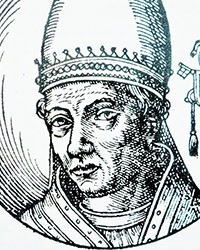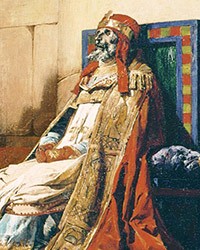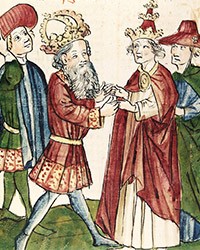Pope Sergius III (approx. 870–911) – meaning „ the slave of every vice”
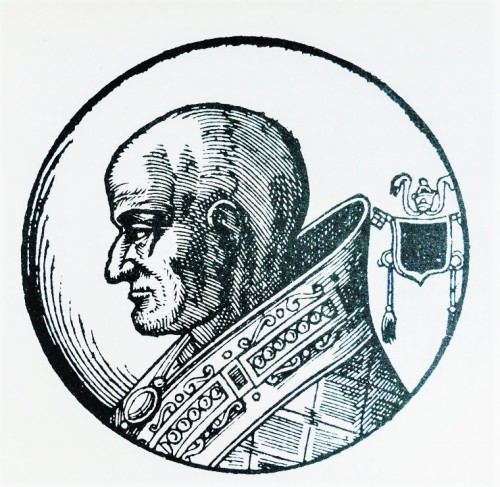
Pope Sergius III, Le vite dei pontifici, 1710, Bartolomeo Platina
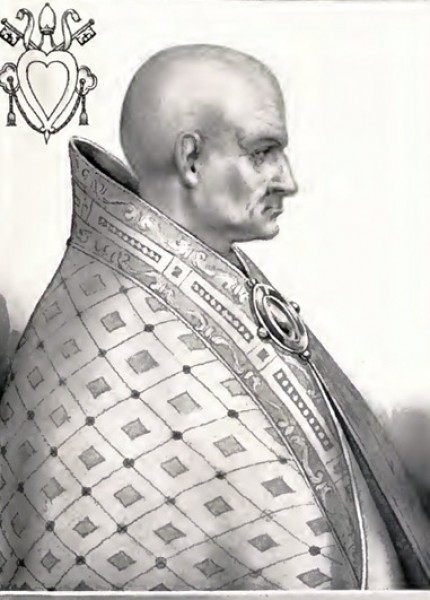
Pope Sergius III, The Lives and Times of the Popes by Chevalier Artaud de Montor, pic. Wikipedia
As the papal confessor and Church historian, Cardinal Caesar Baronius had written about him, Sergius was „ a slave of every vice and the most wicked of men”. During his pontificate the office of the pope lost its dignity and significance, becoming a political cog moved by influential Roman families – important for generating profits, handing out titles and posts. He himself, would be remembered in history as the alleged father of the next pope as well as the lover of Theodora the Elder and Marozia – meaning the successor of St. Peter controlled by dangerous women.
As the papal confessor and Church historian, Cardinal Caesar Baronius had written about him, Sergius was „ a slave of every vice and the most wicked of men”. During his pontificate the office of the pope lost its dignity and significance, becoming a political cog moved by influential Roman families – important for generating profits, handing out titles and posts. He himself, would be remembered in history as the alleged father of the next pope as well as the lover of Theodora the Elder and Marozia – meaning the successor of St. Peter controlled by dangerous women.
He came from a significant family of lords from Tusculum. He chose the career of a clergyman, which was to be crowned with becoming pope. Therefore, he could not have been happy, when in the year 893 he was ordained as the bishop of Caere (present-day Cerveteri), since this shut the door to the bishopric of Rome. The elderly Pope Formosus, in this cunning way got rid of a young political rival. The rest of Sergius’s story is known to us mainly from the chronicler Liutprand of Cremona – connected with the imperial court, who in an unequivocally negative, sometimes even ostensibly biased way describes the relations prevalent in Rome at that time. His words therefore, as well as the words of those who had for ages repeated his opinions (including Baronius), should be treated with a high dose of skepticism.
After the enthronement of Pope Stephen VI, Sergius became his supporter. They shared a common dislike, even hatred of Pope Formosus, which culminated with the Cadaver Synod (897) called by Stephen, which would be remembered in history as one of the most macabre trials. The twenty-seven-year-old bishop of Caere also played an active part in it. Pope Stephen VI did not enjoy his victory over the previous, deceased pope for a long time, since a few months later he died, or more appropriately was strangled by an assassin. Sergius reached for the papal tiara immediately after and he almost obtained it, occupying the Lateran and bringing about his election (897) but he had to abdicate on behalf of John IX. Apparently his time had not yet come, especially since the new pope desiring to get rid of his competitor, excommunicated Sergius and ordered him to be exiled. For the next several years Sergius patiently waited for his moment to arrive. After the death of John IX, a battle for St. Peter’s throne ensued in Rome. The newly elected Pope Leo III, had died in prison under mysterious circumstances, while when Presbyter Christopher acquired the papal tiara he was imprisoned and most likely killed. As Liutprand of Cremona claims, both were murdered at the orders of Sergius. We can only assume what happened afterwards. The aristocrats ruling in the city, with the family from Tusculum at their head, were quite pleased with the perspective of a relative of theirs assuming the papal throne – so it should come as no surprise that they supported him in his actions. In the year 904 Sergius became pope. However, the power and the prerogatives regarding secular matters (including financial ones) lay with Theophylact, who called himself a Roman senator and consul and who was married to Theodora the Elder. What did Sergius do at this time? Driven by pragmatism, but not wild hatred (although it cannot be discounted) he decided – following an example set by his predecessor Stephen VI – to once again start the trial against the previously judged cadaver of Formosus, reenacting in a sense the Cadaver Synod in a lighter version. And while the pope’s corpse was not once again seated upon the throne, it was – once again sentenced – taken out of its tomb and thrown into the Tiber, while all the decisions of the pope were revoked, including those about ordinations (which were in the meantime reinstated by John IX). What was really behind this whole macabre? The devil was in the details. It was successfully tested in a similar way by Stephen VI – so nobody could question the legality of the pontificate of Sergius III. The fact that he was the bishop of Caere, made his election to the post of pope impossible due to the cannon law in force at that time. The whole trial also served another purpose – all the clergymen ordained by Formosus, who were presently stripped of their holy orders, became completely dependent upon the good or bad will of Sergius III. He could ordain them once again and ensure their salaries or not, depending on their loyalty and utility.
Apart from these games, the pope spent the rest of his time (according to Liutprand of Cremona) on enhancing the life of the wife of his protector Theophylact – Theodora. She entered the annals of history – thanks to the aforementioned chronicler – as a harlot and an ambitious woman, while the words used to slander her would be difficult to bring up without feeling ashamed. It is enough to point out that they were the reasons for the term pornocracy, used to describe the rule of harlots and prostitutes. If we deem that source as trustworthy, Theodora was not only the pope’s lover but also the procuress of her own daughter – the fourteen year old at that time Marozia. The son born out of her relationship with Sergius, Alexander later became Pope John XI. However, we do not have any evidence that this is indeed the truth. On the other hand, we can have no doubts that Sergius had more of the ambition and pride of a Roman aristocrat than Christian virtues, while the breaking of celibacy by popes was – well – something traditionally accepted.
One thing for which he can be praised was the reconstruction – even if done to make his life more comfortable – of the official papal residence (the Lateran Palace) as well as the Lateran Basilica (San Giovanni in Laterano), after an earthquake which took place in 897, after the Cadaver Synod. In his way Sergius probably had desired to wipe out the odium of the divine wrath, which is how the cataclysm was viewed at that time. He not only rebuilt the basilica and gifted it richly with liturgical vessels as well, but also had an entrance portico erected supported by ten ancient columns. All this disappeared during the construction of a new façade in the XVIII century.
The pope died of natural causes, which on one hand was something unusual at that time, while on the other may be a testimony to his good cooperation with the omnipotent at that time Theophylact of Tusculum, despite the alleged sexual relations with his wife Theodora and daughter Marozia. He was buried in the renovated Lateran Basilica, but in time all traces of his tomb were lost.







